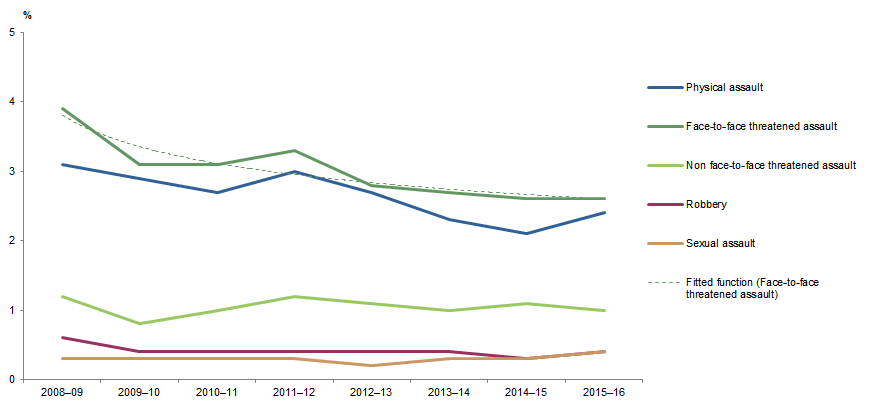AUSTRALIA
HOW HAVE PERSONAL CRIME VICTIMISATION RATES CHANGED OVER TIME?
The fitted function analysis showed a decline in the victimisation rate for face-to-face threatened assault in Australia since 2008–09, although the rate of this decline is slowing. No fitted functions that met the inclusion criteria were identified for physical assault, non face-to-face threatened assault, robbery or sexual assault.
VICTIMISATION RATES, Selected personal crimes, Australia, 2008–09 to 2015–16(a)(b)

Australian Bureau of Statistics
© Commonwealth of Australia 2017.
Footnote(s): (a) The fitted functions used to analyse patterns of change in victimisation rates over time have not taken into account the survey error associated with the annual victimisation rates. This is expected to have a negligible impact on the analysis, as the survey error is small. For further information on survey error refer to the Technical Note. (b) Fitted function is: face-to-face threatened assault is a power function with equation y = 3.8083x-0.184 R2 = 0.853
Source(s): Crime Victimisation, Australia
HOW HAVE HOUSEHOLD CRIME VICTIMISATION RATES CHANGED OVER TIME?
The fitted function analysis showed a decline in the victimisation rates for break-in, motor vehicle theft, theft from a motor vehicle, malicious property damage and other theft in Australia since 2008–09. The victimisation rate for attempted break-in has generally declined over the same time period, although this has plateaued since 2012–13.
VICTIMISATION RATES, Selected household crimes, Australia, 2008–09 to 2015–16(a)(b)

Australian Bureau of Statistics
© Commonwealth of Australia 2017.
Footnote(s): (a) The fitted functions used to analyse patterns of change in victimisation rates over time have not taken into account the survey error associated with the annual victimisation rates. This is expected to have a negligible impact on the analysis, as the survey error is small. For further information on survey error refer to the Technical Note. (b) Fitted functions are: break-in is a logarithmic function with equation y = -0.344ln(x) + 3.2691 R2 = 0.9158; attempted break-in is a polynomial function with equation y = 0.0446x2 - 0.5244x + 3.4589 R2 = 0.8958; motor vehicle theft is a logarithmic function with equation y = -0.279ln(x) + 1.0952 R2 = 0.9823; theft from a motor vehicle is a power function with equation y = 4.2751x-0.228 R2 = 0.9232; malicious property damage is a logarithmic function with equation y = -2.946ln(x) + 11.28 R2 = 0.9818; other theft is a power function with equation y = 4.4189x-0.214 R2 = 0.9517.
Source(s): Crime Victimisation, Australia
 Print Page
Print Page
 Print All
Print All
 Quality Declaration
Quality Declaration